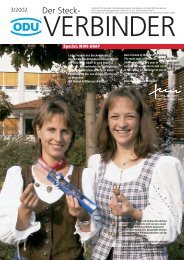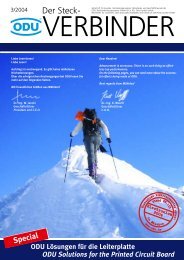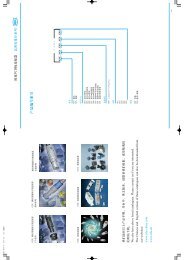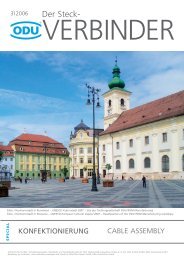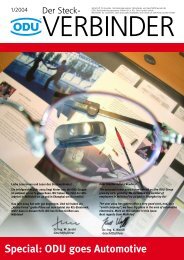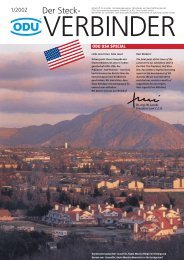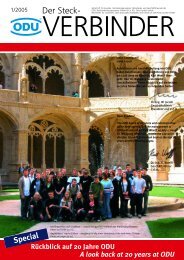DER STECKVERBINDER 3 2012 - ODU
DER STECKVERBINDER 3 2012 - ODU
DER STECKVERBINDER 3 2012 - ODU
Erfolgreiche ePaper selbst erstellen
Machen Sie aus Ihren PDF Publikationen ein blätterbares Flipbook mit unserer einzigartigen Google optimierten e-Paper Software.
NEUES AUS DEM BETRIEB | NEWS FROM OPERATIONS<br />
Die Zukunft kann kommen!<br />
We’re Ready for the Future!<br />
Volker van der Pütten<br />
Leiter Oberflächentechnik<br />
Manager Surface technology<br />
Erweiterung der Galvanik: Mit neuer Aluminium-Anlage<br />
gewappnet für die Zukunft<br />
<strong>ODU</strong> hat in den Bau eines neuen Fertigungsgebäudes sowie<br />
in die Anschaffung und Inbetriebnahme einer Aluminium-<br />
Galvanisierungsanlage investiert. Eine Erweiterung der Galvanik<br />
war notwendig geworden, da die im Jahr 2008<br />
installierte Chromanlage bei Vollauslastung ihre Kapazitätsgrenze<br />
erreicht hatte.<br />
Zur selben Zeit startete das <strong>ODU</strong> AMC-Projekt, bei dem es<br />
um eine neue Oberfläche (Ruthenium) und einen anderen<br />
Grundwerkstoff (Aluminium) ging. Der Neubau sollte also<br />
einerseits der Erweiterung der Chromkapazität dienen und<br />
anderseits den Anforderungen des <strong>ODU</strong> AMC-Projektes<br />
gerecht werden. Diese Anforderungen ergaben sich aus den<br />
Merkmalen der neu entwickelten <strong>ODU</strong> AMC Steckverbindung.<br />
Diese wird zwecks Gewichtseinsparung aus Aluminium<br />
gedreht. Außerdem soll ihre Oberfläche bestimmte<br />
Eigenschaften aufweisen wie z.B. RoHS-Konformität, geringer<br />
Übergangswiderstand, gute tribologische Eigenschaften<br />
und hohe Korrosionsbeständigkeit. Ebenso soll sie<br />
blendarm und dunkel sein. Als Endschicht wurde hierfür<br />
Ruthenium gewählt, das all diese Anforderungen erfüllt.<br />
Ruthenium gehört zu den Platinmetallen und ist aufgrund<br />
seines edlen Charakters sehr korrosionsbeständig.<br />
Expansion of the electroplating area: Ready<br />
for the future with new aluminum system<br />
<strong>ODU</strong> has invested in the construction of a new manufacturing<br />
building as well as in the acquisition and commissioning of an<br />
aluminum electroplating system. It was necessary to expand<br />
the electroplating section because the chrome-plating machine<br />
which has been installed in 2008 had already reached its capacity<br />
limit.<br />
At the same time, the <strong>ODU</strong> AMC project started, and this involved<br />
a new surface (ruthenium) and another base material (aluminum).<br />
The new building was intended to house the expansion<br />
to the chrome capacity and also satisfy the requirements of the<br />
<strong>ODU</strong> AMC project. These requirements resulted from the features<br />
of the newly developed <strong>ODU</strong> AMC connectors, which are<br />
lathed from aluminum in order to save weight. Their surface<br />
was furthermore intended to have certain characteristics, such<br />
as RoHS conformity, low contact resistance, good tribology<br />
characteristics and high corrosion resistance, and furthermore<br />
be low-glare and dark. Ruthenium was selected for the final<br />
layer here, because this material satisfies all these requirements.<br />
Ruthenium is a platinoid and very corrosion-resistant thanks to<br />
its noble character.<br />
The criteria for the plant planning were consequently given, and<br />
the new machine was connected to the existing system. The<br />
working capacity that resulted is impressive: It is now possible to<br />
provide a surface finishing of copper, nickel, chemical nickel,<br />
satin nickel, chrome, black chrome, white ruthenium, black<br />
ruthenium and palladium-nickel on the base metals aluminum,<br />
stainless steel, copper and their alloys for some 22 million individual<br />
parts a year.<br />
But this was not the only system to be expanded. As a part of the<br />
same action, it was also necessary to enlarge the waste water<br />
treatment plant, set up a new chemical laboratory, install a corrosion<br />
test chamber and enlarge the surface inspection area. A<br />
new building provided the space for this. It also houses a small<br />
administration tract and social areas for the surface technology<br />
employees.<br />
To optimize the flow, the sand-blasting area was integrated into<br />
the surface technology building. The tampon printing as well as<br />
a number of other process steps will be coming soon, because<br />
this will optimize and accelerate a number of work processes,<br />
such as blasting, attachment, inhouse electroplating system,<br />
inspection and tampon printing, in one flow.<br />
We’re ready for the future!<br />
22 | Der Steckverbinder





